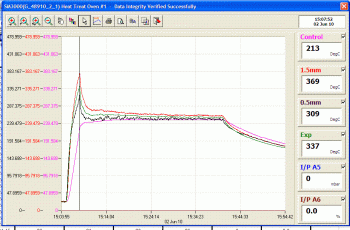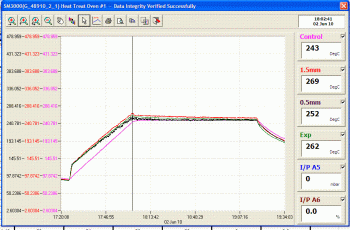This is something to be expected. Evenheat will almost certainly have found that their customers want fast heating to Austenitizing temperatures and will have tuned the controller accordingly. This will tend to result in substantial overshoot at the much lower tempering temperatures unless steps are taken to prevent it.
Assuming you have one of the Ramp/Soak-capable controllers, setting a slow ramp to temperature will prevent the overshoot.
Back when I built my first HT oven, I did some testing using a borrowed-from-work high-end industrial controller, along with a series of different-diameter thermocouples and a datalogger. The aim was to get some sort of idea of the effect of direct radiant heating on a blade profile and to see which of the higher-end features would actually be useful in this application.
Temperatures are in degC. The control thermocouple was a 6mm diameter Mineral Insulated type N. The others were 0.5mm MI, 1.5mm MI and an exposed-junction type K. I suspect all the MI thermocouples had Insulated junctions, but cannot be certain: the response of the 1.5mm suggests it may have had a Grounded junction.
The controller had been autotuned at 800 degC (1472 degF) and the setpoint was 250 degC (482 degF) in both cases.
Without a ramp, the peak overshoot was to 119 degC (214 degF) above setpoint. With a 30-minute ramp, peak overshoot was 19 degC (34 degF) above the setpoint.
No overshoot whatsoever was evident from the controller, which was only "seeing" the control thermocouple.
Lessons I learned from this included:
1/ Use the fastest-response control thermocouple possible.
2/ Use a Ramp/Soak controller.
3/ Always ramp to tempering temperature.




